Is SEO dead? How to stay discoverable in the age of AI, zero clicks, and multichannel discovery?
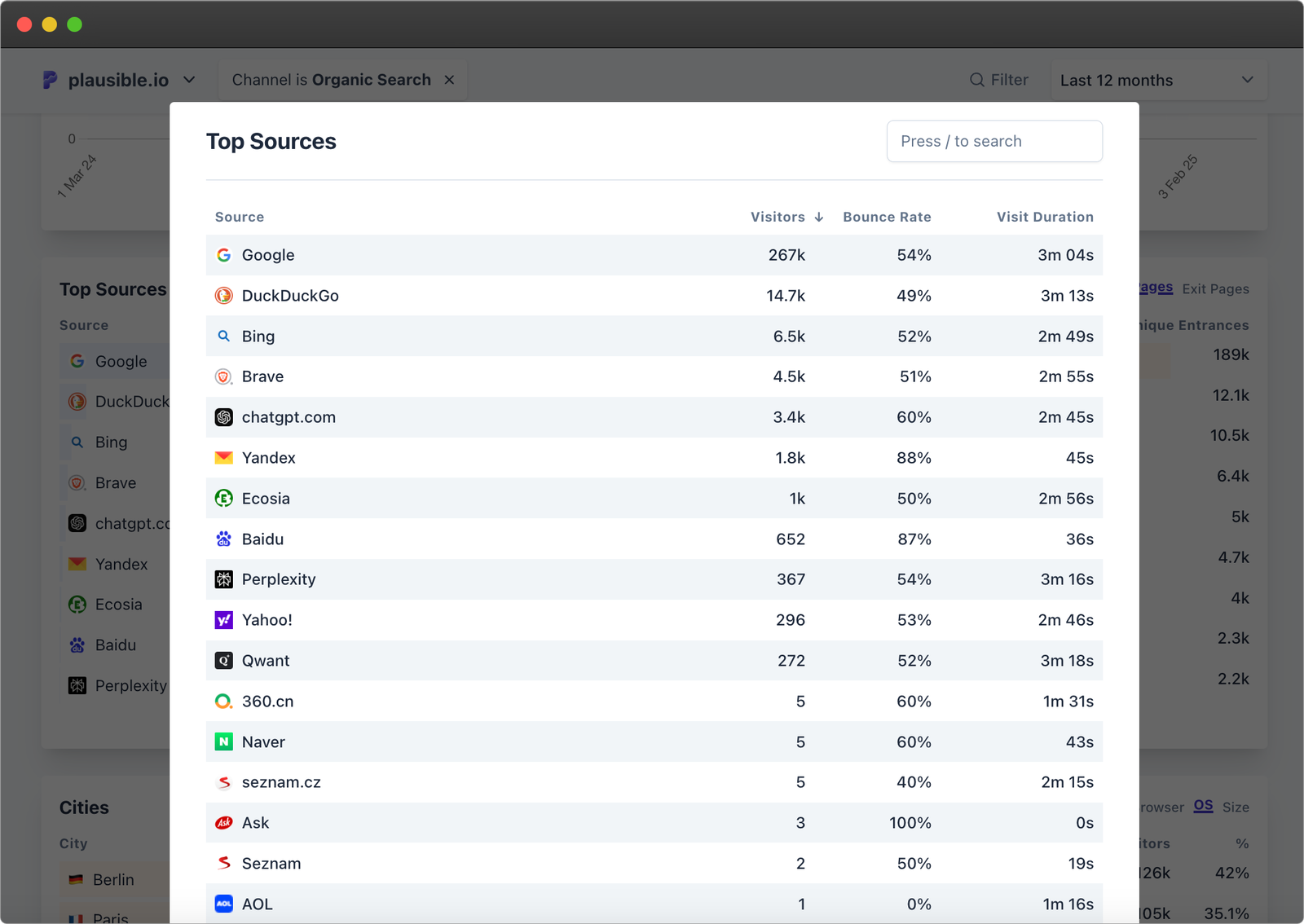
It’s an interesting time to be an online business, catching up with rapidly shifting “trends” regarding AI, increasing concerns around consumer privacy, and the one you can’t miss: shifting SEO –– one of the most favourite channels of digital marketers for more than two decades.
Some people on LinkedIn and other niche communities claim how “SEO is dead” (trust me, that’s been a pretty common thrown-around phrase), others beg to differ and encourage to adapt.
Meanwhile AI is being adopted more and more all over the world, privacy-conscious users are increasing, and it can all feel overwhelming. We try to take an objective view at everything and provide answers to what SEO looks like in 2025, how to adapt, what are some things to take care of, and how to measure it all in Plausible.
- Is SEO dead in 2025?
- So, what to do?
- Analyzing organic search traffic
- Why use Plausible for SEO analysis?
Is SEO dead in 2025?
This is a good time to revisit what SEO even means. “Search Engine Optimization” is the method of optimizing whatever content you push on the web in a way that search engines like to present it (preferably on the first page of search results) to the people who search for related queries.
There are essentially two parts of this “optimization.” One is hunting keywords to understand what people are asking on search engines and if relevant to you, writing content to offer answers to those questions. Second is making the content presentable, easily readable, accessible, etc. (the on-page, off-page and technical SEO bit of it).
The second part is something that content makers should anyway do, i.e. provide a good reading experience. But what lies at the core of all of it is the first part. So let’s break that down by asking three questions:
Have people stopped asking questions on the web?
Not at all (have you?).
Is the place and the way everyone searches for answers on the web evolving?
Certainly. Think AI chatbots, privacy-first browsers, etc.
Has your overall organic traffic dropped?
Hmm, moment of truth. So, I decided to check ours at Plausible. I simply compared the last 12 months’ organic search traffic and it’s actually increased by 12%.
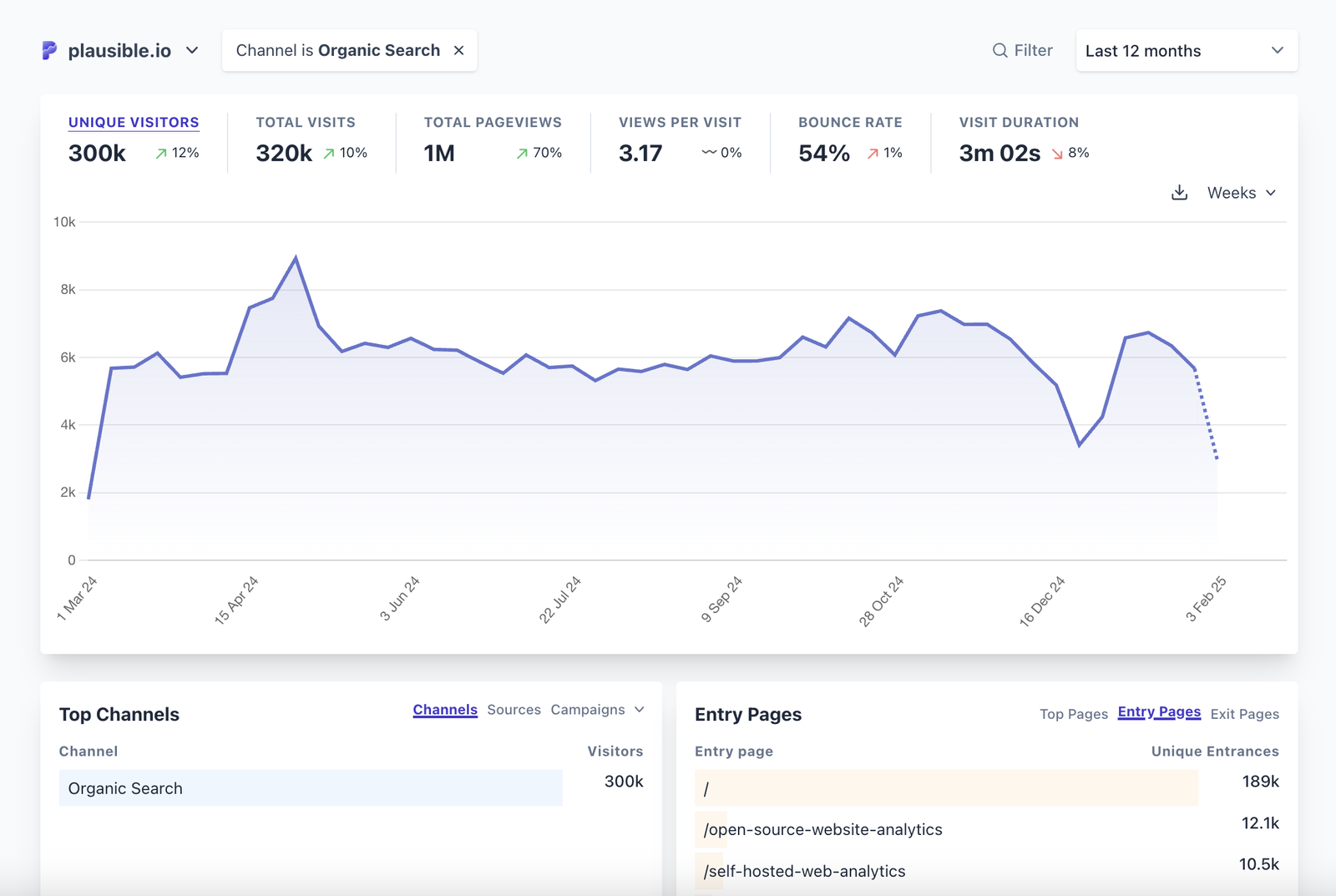
Last 3 months looked stable too. Since Google is the main organic search source that sends the most traffic and is generally equated with SEO, I just looked at traffic sent by Google searches, and the patterns are still similar for us.
If click-through rates from Google search result pages should have been dropping (because SEO is supposed to be dead and AI overviews are the new normal), it didn’t seem to affect us at least.
Not a good sample size but since we seem to be on the “safer” side, this meets our purpose of continuing the study on what is working if SEO is not.
So, traffic has been stable and growing from organic searches. Next, we look at the breakdown of organic sources. Apart from Google, it shows some sources like DuckDuckGo, Brave, ChatGPT, Perplexity, etc.
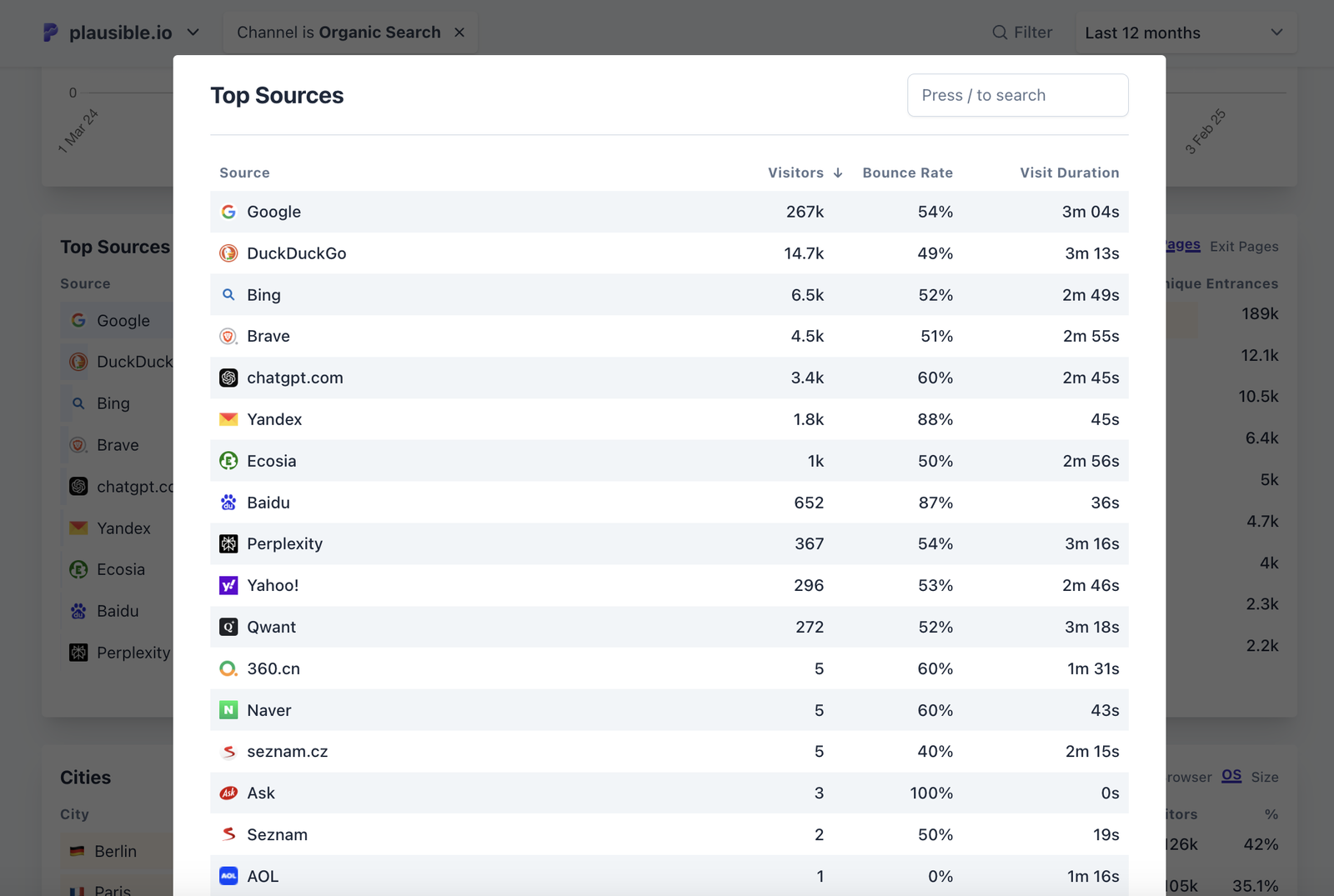
The pattern here is that there are privacy-focused search engines and AI chatbots showing up decently more than the previous years.
The conclusion is simple. Search Engine Optimization is not just about gaming the top search engine in the world anymore, but the ability to be discovered by all the other “replacements.” If I could, I would rename it to organic search optimization.
Yes, there are a few exceptions. Say, you are an ed-tech and compile math exercises as a content strategy, then AI could be taking away some traffic from you by engaging with students in real time, sharing math exercises according to the set difficulty level, helping with formulae, exam questions, etc. In such cases, you will most likely need to adapt the whole content or business strategy itself.
Or, if the nature of questions in an AI chat don’t need a referral link to be shared or a product to be recommended, you could lose out on some traditional traffic but I do think that the balance will be maintained because people need solutions at the end of the day and they will find your high-quality product/service through a method.
So, is SEO dead? Yes and no.
Yes: traditional SEO that only tries to game the system could be dead, or at least struggling. The difference is that search engines have gotten better (and continue to improve) in weeding out content that’s optimized for ranking and not for providing value.
No: If you’ve been providing valuable content. All the newer AI bots, search engines, etc. will find, recommend and cite your content on their own.
So if you’ve been making high-quality content answering real questions of your target audience and the nature of your business allows you to stay afloat, you should be good to go.
So, what to do?
Take care of technical SEO
Since the new age channels are good at discovering your content on their own, we need to make sure that our content is indeed “discoverable.” This would mean the following:
- Optimize crawling and indexing: Use robots.txt, XML sitemaps, and canonical tags to ensure search engines index the right pages.
- Improve site speed and Performance: Minify CSS/JS, enable caching, use a CDN, and optimize images for faster loading.
- Ensure mobile-friendliness & keep the Core Web Vitals in check.
- Enhance website security: Use SSL certificates, HSTS, and security updates to protect against vulnerabilities.
- Optimize internal linking and site architecture: Use a logical hierarchy, breadcrumbs, and internal links to improve navigation and SEO.
- Consider adding an llms.txt file
Optimize for all the “search engines”
As we just saw, organic discovery sources have been spread among newer types of platforms. Beyond Google, optimize your content for alternative search engines like DuckDuckGo, Brave Search, Bing, etc., if you can.
These platforms are gaining more traction due to increasing privacy concerns and evolving user behavior. You can start by ensuring your website is indexed properly on these search engines, testing how your content ranks there, and finding any newer search queries that might be there to answer.
AI traffic is real
Chatbots like ChatGPT, Perplexity, Claude, Deepseek, etc., have become discovery sources. These tools scrape the web for answers and provide direct responses to users. They:
- Suggest a product, leading to “Direct” traffic,
- Cite a source, leading to “Organic Search” traffic on the cited source, or
- Do a web search for you, show results, and answer your question by assimilating information from those sources. This would also lead to “Organic Search” traffic.
Interestingly, we saw a traffic surge of 2,200%+ in 2024 just from AI channels. The whole study along with ways to “AI-optimize” are here.
Speaking of which…it’s worthy to take a moment to observe how AI companions are being utilized now: as a personal note taker, movie recommender, finance manager, strategist helping with big business decisions, and whatnot.
This has raised concerns over vulnerability of personal and sensitive data, since AI gets access to the users’ routines, financial data, and other sensitive information. It’s speculated how this is going to inspire a lot of policies and regulations this year around the world, which brings me to the next point.
Run along with privacy
This is a bit wary of our main discussion about organic search traffic but since privacy as a factor is changing user behavior, I feel compelled to talk about it as an essential piece of the puzzle.
Your consumers care more and more about privacy. Becoming more customer oriented than algorithms oriented can be a key strategy. Consider these:
- Companies like Apple have used privacy as a competitive advantage by educating and protecting its users from being tracked by introducing features like Private Relay, app tracking protection, etc.
- Companies like Meta, Amazon, Google, WhatsApp, Tiktok, etc. have faced GDPR fines in millions of dollars within the last few recent years. In fact, Meta faced a fine of €1.2 billion in May 2023. All this for mishandling personal data.
- Third-party cookie tracking is coming to a demise, which we covered here.
- Increasing use of VPNs, ad blockers, and private browsing tools. Another study we did here that revealed 58% of tech-savvy audiences use such methods.
- There is a shift towards self-hosted and decentralized services as users move away from centralized Big Tech platforms.
- Younger generations are increasingly aware of data rights and privacy risks.
- If you run a quick Reddit search, you’ll notice communities of privacy anxious individuals with a combined total of 1.7M members.
If this is not enough, know that 120 countries have established privacy and security regulations just like the GDPR to protect their peoples’ data privacy.
It’s much easier to build a privacy-friendly tech stack for your business rather than navigating all those regulations with costly legal aid.
Respecting and proactively protecting your customers’ privacy can very realistically emerge as a brand differentiator, and hence, help your overall traffic and business.
Analyzing organic search traffic
Let’s get to the measuring organic search (the “new SEO”) part of the equation. Here’s everything you want to be able to do:
- See all organic search traffic together, while seeing a breakdown of specific sources like Google search traffic, Perplexity traffic, and so on.
- Understand which content is effective in driving such organic traffic
- Understand which search terms drive traffic the most
- Engagement metrics like time on page, bounce rate, scroll depth, etc.
- Assess how well organic traffic contributes to conversions like sign-ups, purchases, form submissions, etc.
All of this is possible to do with Plausible. If you have been in SEO even for a bit, you’ll know how tough it can get to analyze your traffic in Google Analytics which is the traditional choice.
For all the research work (keyword analysis, competitive analysis, etc.), we suggest you use the specialized SEO tools. But analyzing such traffic on your website needs a web analytics tool. All of this can be done with Plausible.
You can play around with our live demo, if you don’t have a Plausible account.
See overall organic search traffic
We have a pre-built “Top Channels” report in the dashboard which automatically consolidates relevant traffic sources into their respective channel types such as Direct, organic search, organic social, etc.
This makes it super convenient to see all organic traffic together rather than piecing different traffic sources together from different reports, or relying on custom reporting.
When you click on the organic search entry (like shown in the case study above), your dashboard filters by it to only show data relevant to organic search, and you get to see a “Top Sources” report with a breakdown of these organic search channels.
This is an expandable report that shows the sources by visitors, bounce rate, and visit duration, which you can sort by as well. You can click on any of such sources to filter further. Take a look here.
Assess effective content
In the filtered dashboard, you can use the Entry Pages report to see which pages attract the most organic search visitors. This is also an expandable report with metrics you can use to sort your landing pages by.
You can click on any row to further filter the dashboard and study that landing page: its bounce rate, geographies it was visited from, goal conversions in the sessions acquired through this page, etc.
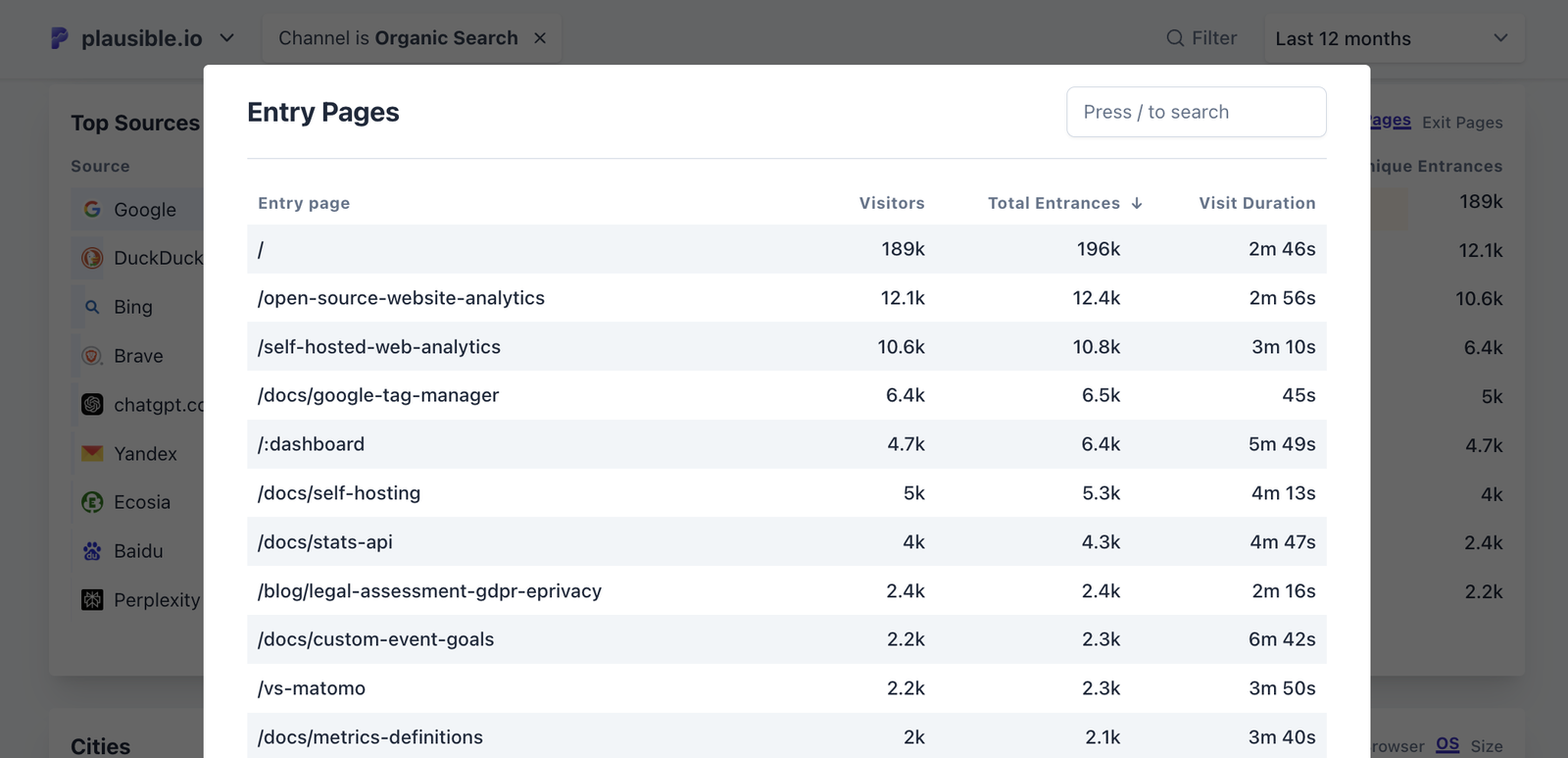
Assess effective keywords
You can break down your Google search traffic further by integrating your Google Search Console account with Plausible. You’ll be able to see the search terms that got you traffic from Google directly in the Plausible dashboard.
Compare the queries driving traffic with the Entry Pages report to see which content aligns with search intent. Over time, you can monitor which keywords gain traction and adjust your content strategy accordingly.
Correlate conversions and other things
That’s it. Now you can also see your goal conversions (learn how to set them up here) in this filtered dashboard. You can also see the used devices, operating systems, popular locations, etc.
You can use a mix and match of filters to create your segments and analyze organic traffic further. For eg. I can apply the following four filters to assess how many people signed up for our free trial from organic searches, landing on the homepage, in England.
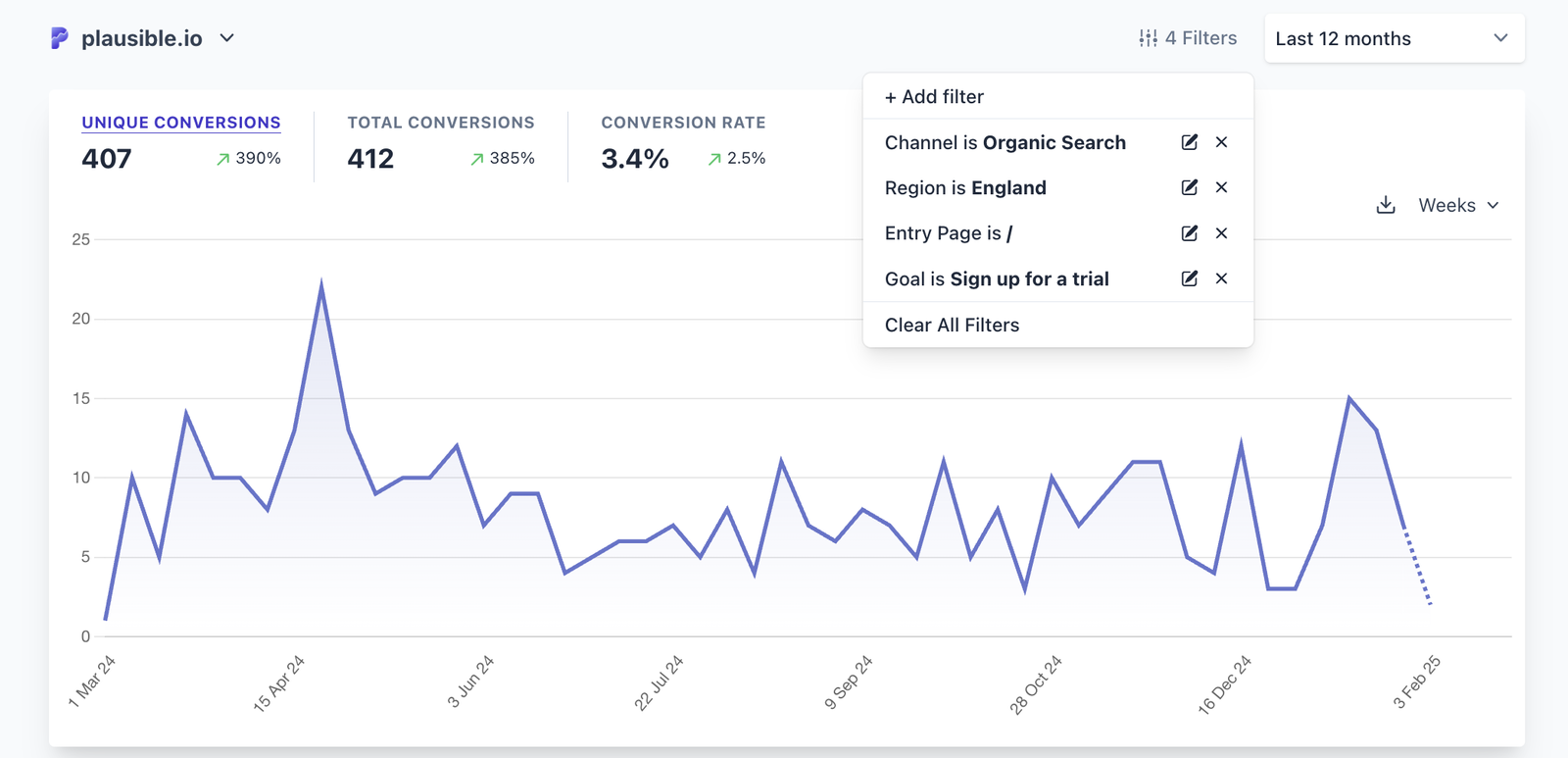
You can check out this exact segmented dashboard here.
Why use Plausible for SEO analysis?
Plausible is an open-source, simpler, and privacy-friendly alternative to Google Analytics.
- Everything is in one place. Unlike traditional tools like Google Analytics, where you need multiple reports or custom explorations, we keep it simple with a single-page dashboard. In fact, it’s easier to track visits, exit pages, conversions analysis, and a lot of things in Plausible than GA4.
- Our stats are very accurate as we take special measures in ensuring so. This is another differentiator from most analytics tools.
- We don’t rely on cookies or invasive tracking, ensuring privacy-friendly analytics and out-of-the-box compliance with GDPR, and similar laws around the world.
P.S. Now you can even make your own SEO dashboard that suits your needs the best in Looker Studio using our brand new connector. I’m thinking of making one as a template for SEO professionals, should I?